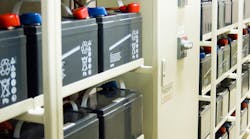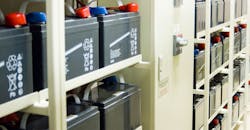Article 320 of NFPA 70E provides safety requirements for working on and around storage batteries. As with other Articles in this standard, it takes a concept approach rather than a highly detailed, prescriptive approach. This fact becomes clear at the outset, when you read the Informational Note under the Scope [320.1]. It lists not just two or three other standards, but eleven.
These other standards provide “additional information on best practices for working with exposed stationary batteries that exceed 50V, nominal.” Six of these are IEEE standards, two are NFPA standards, and two are OSHA standards. There’s one from DHHS (NIOSH).
What’s in a word?
Section 320.2 defines 10 terms. For people regularly engaged in battery work, these terms and their “battery lingo” definitions are familiar. Yet many words commonly used in battery work are not listed here (e.g., string and float charge). You will encounter a much larger “battery lingo” vocabulary when reading through the 11 standards mentioned earlier.
Assessment
NFPA 70E makes risk assessment a core safety practice. For battery work, the risk assessment must address three types of hazard [320.3(A)]:
- Chemical
- Electric shock
- Arc flash
You must also assess the risks associated with the types of tasks to be performed. The task of cleaning battery terminals presents different risks than the task of measuring the float voltage on a string.
The room
Each battery room or enclosure must be accessible to only authorized personnel [320.3(A)(2)(c)]. Does this mean a sign or a lock? Art. 320 doesn’t say, so consider these things.
Locks almost certainly ensure there won’t be unauthorized access. However, locks cost money and can cause delays when quick access is critical. If conditions are such at the facility that a sign will do the job, a sign may be sufficient.
For example, in a limited access facility, such as a manufacturing plant or power generating plant, a physical lock can also be used, but a sign may be all that’s needed if all employees are properly trained.
At one Midwestern power generating plant, two emergency generator rooms have double doors. Years ago (and maybe still), those doors were normally left standing open. Nobody entered either room without going to the operations room, verbally obtaining permission, and signing a form with expected entry time and exit time. This was an administrative control, and nobody ever violated it. Under certain conditions (e.g., smoke detected), an alarm would sound, and the doors would close in 60 seconds.
This plant had many rooms with “administratively locked” doors. You’d swipe your card before entering and when leaving; the operators could monitor occupancy on their screen. This kind of “honor system” works if everyone is trained and the whole facility is securely restricted access. If not, keep untrained people from encountering dangerous equipment via locks and/or other barriers.
A problem electrical workers encounter in facilities across the country is implementation of the idea they need restaurant ambiance lighting instead of work-sufficient lighting. This is inefficient, wasteful, and dangerous. For battery rooms, it’s prohibited [320.3(A)(2)(b)].
The lighting should be engineered for the space and its contents, and the work to be performed, so there is adequate illumination to work without a flashlight or portable lamp. This is one area where seeing what you can get by with may prevent someone else from seeing what they’re doing.
Watch what you wear
You can’t wear electrically conductive objects, such as jewelry, when working on a battery system [320.3(A)(3)]. Did you know many tattoo inks are also conductive? Art. 320 doesn’t go further than “objects” about what to wear around batteries.
The (non-Art. 320) list of “don’t wear around electrical” includes anything made of polyester. Cotton clothing burns, but polyester melts. If your microfiber slacks encounter a spark, part of that material will melt into your skin. You get a deep burn that you can’t stop.
Don’t forget your personal protective equipment (PPE) [Table 130.7]. Regardless of what you’re doing in the battery room, you must wear:
- Hardhat
- Safety glasses or safety goggles
- Leather footwear
Depending on the ambient noise, you also may need hearing protection. The test for this is if you must raise your voice to have a conversation, then you need hearing protection.
Abnormal battery conditions
Many battery installations have monitoring systems that provide an alert upon detecting an abnormal battery condition. These systems are great, except when they’ve been neglected yet you’re still relying on them. Make sure those systems get their recommended maintenance.
Also, they must be tested annually [320.3(A)(4)]. The Informational Note here provides some detail about these systems and how to find out more. If you don’t have such a system, you’re letting a lot ride on luck. If you do have such a system, take the time to evaluate its appropriateness for the battery technology you have and its completeness in providing a satisfactory level of monitoring. Don’t forget to have someone monitor the monitor.
Warning signs
You need four types of warning signs, posted in appropriate locations [320.3(A)(5)]:
- Electrical hazards: shock, arc flash, and thermal
- Chemical hazard warnings
- PPE notices
- Access restricted to authorized personnel
Handling electrolytes
The employer must make specific protective equipment available to employees performing any type of service on any type of battery that has a liquid electrolyte [320.3(B)(1)]. These are:
- Goggles and face shield appropriate for the specific chemicals that may be encountered
- Gloves and aprons appropriate for the specific chemicals that may be encountered
- Portable or stationary eyewash facilities within the work area
If the work activity doesn’t involve handling electrolytes, then at a minimum safety glasses are required [320.3(B)(2)]. This is the most common scenario in battery work; as the Informational Note states, battery maintenance typically does not involve handling electrolyte.
Direct-current ground-fault detection
Not all battery systems have DC ground-fault detection but many do. The ground-fault detection used must be based on the grounding methodology being used [320.3(C)(1)]. This Section has an extensive Informational Note that provides discussion of four types of DC grounding systems commonly used.
Tools and equipment
The handles of tools and equipment must be listed as insulated for the maximum working voltage [320.3(C)(2)(a)]. Another requirement is the battery terminals and all electrical conductors be kept clear of unintended contact with tools, test equipment, liquid containers, and other foreign objects [320.3(C)(2)(b)]. At first glance, it would seem this is worded backward; simply keep your tools away from the battery terminal conductors to prevent accidental contact. Good luck with that.
One of the protection techniques is to place an insulating barrier, such as an insulating blanket, over the terminals or conductors you want to protect from accidental contact. This way you’re not relying on a lack of human error to prevent a catastrophe.
NFPA 70E requires performing a risk assessment [110.1(G)]. That assessment might reveal the presence of flammable gases, which are often found in battery rooms. If that’s not the case or even might be the case, that assessment justifies the use of non-sparking tools. If it does, use of those tools is required [320.3(C)(2)(c)].
It’s OK to vent
The vented lead acid battery is the most common battery type used in high-density, high-reliability applications such as data centers. Gassing is a natural consequence of the chemical reaction inside the jar, and that’s why these batteries have vents. Ensure vents are unobstructed [320.3(D)].
Cell flame arresters are also commonly used, but their operation depends on their proper installation and maintenance. If you see cell flame arresters, stop. Ensure the maintenance procedure addresses them. If not, use the manufacturer’s instructions to update those procedures.
Staying safe around batteries
Acid burns, electric shocks, back injuries, and gas explosions are some of the hazards of working with batteries. Art. 320 will give you a good understanding of basic safety principles, but also become familiar with the related standards listed in Sec. 320.1. Remember that stopping to observe before entering a battery room is your first line of defense.
Lamendola is an electrical consultant located in Merriam, Kan. He can be reached at [email protected].





